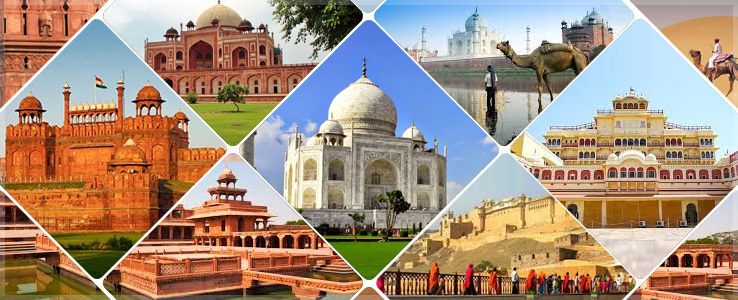India’s famed Golden Triangle—comprising Delhi, Agra, and Jaipur—is a cultural corridor that offers deep insights into the country's history, architecture, and evolving traditions. Travelers who journey through these three iconic cities experience the essence of India’s heritage and diversity. This guide explores each city's cultural highlights and showcases how they collectively form an unforgettable travel circuit rooted in centuries of civilization.
Delhi – The Historic Capital with Many Layers
Delhi, India's capital, is a dynamic blend of ancient traditions and modern progress. Its historical significance is evident in its layered urban fabric, which tells stories from different dynasties, empires, and eras.
Old Delhi is the first stop for cultural immersion. Built by Mughal Emperor Shah Jahan in the 17th century, the area is home to iconic landmarks such as Red Fort and Jama Masjid, surrounded by bustling bazaars like Chandni Chowk. These markets not only showcase traditional crafts and street food but also reflect the everyday rhythm of local life.
New Delhi, designed by British architect Edwin Lutyens, features wide avenues and colonial-era buildings like India Gate, Rashtrapati Bhavan, and Connaught Place. Museums such as the National Museum and Indira Gandhi Memorial present a comprehensive view of India’s freedom movement and post-independence history.
Cultural performances at Kamani Auditorium or NSD Theatre Festival reflect Delhi’s continuing engagement with traditional and contemporary art forms. The city’s religious diversity is also visible through its many places of worship, such as the Lotus Temple, Gurudwara Bangla Sahib, and Akshardham Temple.
Delhi’s eclectic blend of Mughal, colonial, and modern elements marks the beginning of any insightful golden triangle india tour package, setting the stage for what follows.
Agra – The Timeless Legacy of the Mughal Empire
Agra, once the heart of the Mughal Empire, stands as a symbol of artistic brilliance and imperial grandeur. The city’s architecture, cuisine, and crafts are heavily influenced by Persian and Central Asian traditions introduced during the Mughal rule.
The most iconic monument is the Taj Mahal, a UNESCO World Heritage Site and a masterpiece of Mughal architecture. Constructed by Emperor Shah Jahan in memory of his wife Mumtaz Mahal, its white marble facade and symmetrical design represent a unique combination of Islamic, Persian, and Indian styles. Just a short drive away, the Agra Fort offers insights into the administrative and military structure of the Mughals, featuring palaces, mosques, and intricate sandstone work.
Another cultural gem is the Itimad-ud-Daulah’s Tomb, often called the "Baby Taj." Built earlier than the Taj Mahal, it displays delicate marble inlay work and is considered a precursor to the architectural style of the larger mausoleum. Visitors can explore all these landmarks in a single day through the Same Day Guided Tajmahal Tour with Agra Fort and Baby Taj, offering a well-rounded glimpse into Agra’s artistic and historical depth.
Agra’s bazaars, especially Kinari Bazaar and Sadar Bazaar, reflect the city’s artisanal heritage. From zardozi embroidery to marble inlay souvenirs, local craftsmanship has preserved Mughal techniques that continue to thrive today.
Jaipur – The Regal City of Forts and Folk Traditions
Jaipur, the capital of Rajasthan, represents the artistic soul of India’s desert culture. Designed in 1727 by Maharaja Sawai Jai Singh II, it follows a grid-like plan and is famously known as the “Pink City” due to the color of its old city buildings.
The city is adorned with architectural marvels like the Amber Fort, City Palace, Jantar Mantar, and Hawa Mahal. Each structure reveals different aspects of Rajputana design, astronomy, and governance. These forts and palaces serve not only as tourist attractions but also as archives of a rich feudal past.
Beyond monuments, Jaipur's cultural identity is deeply embedded in its living traditions. Folk dances like Ghoomar and Kalbelia, puppet shows, and classical music performances continue to be a part of local festivities and gatherings. The Albert Hall Museum and Jawahar Kala Kendra are centers where visitors can engage with Rajasthan’s diverse art forms.
Markets such as Johari Bazaar and Tripolia Bazaar are known for traditional jewelry, textiles, and blue pottery—each item telling a story of regional aesthetics and craftsmanship. A wide range of Rajasthan Tour Packages help travelers explore these cultural elements beyond Jaipur, extending to places like Udaipur, Jodhpur, and Bikaner.
For those interested in wildlife and ecology, the Ranthambore Gypsy/Jeep Safari offers a thrilling contrast to the cultural landmarks, presenting the natural beauty of Rajasthan and its endangered Bengal tiger population.
Conclusion
The Golden Triangle’s cultural fabric is woven with threads of ancient history, diverse religious practices, artistic traditions, and regional pride. Delhi’s layered past, Agra’s imperial elegance, and Jaipur’s royal flair collectively form an experiential journey through the soul of India. Each city offers unique insights while complementing the others, making the Golden Triangle an essential route for culturally curious travelers. This well-rounded itinerary is further enhanced by guided day trips, heritage safaris, and curated local experiences, enabling deeper connection with India’s historical and cultural evolution.
